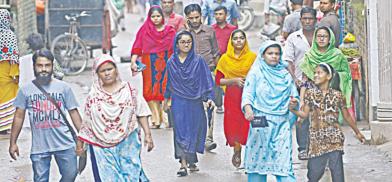'1 in 10 in Dhaka may have been infected with Covid-19'
The World Bank has warned that one in every 10 people in Dhaka might have already been infected with Covid-19, adding that the coronavirus pandemic is not likely to pass anytime soon

The World Bank has warned that one in every 10 people in Dhaka might have already been infected with Covid-19, adding that the coronavirus pandemic is not likely to pass anytime soon.
The World Bank has released a report titled "Beaten or Broken? Informality and Covid-19", which comes amid a steady number of daily infections and deaths in Bangladesh, raising the possibility of a second wave in the winter season.
The total number of confirmed cases in the country stood at 374,592 after the authorities recorded 1,441 new cases on Thursday.
Twenty people died from the virus during the same period, taking overall death toll to 5,460.
So far, more than half of the victims are from Dhaka division, according to the Directorate General of Health Services (DGHS).
The country's death rate stood at around 1.46 per cent.
The report further said that even if the actual infections were much higher than the registered cases, it seemed unlikely that Bangladesh and other South Asian countries were already close to the levels that would trigger herd immunity.
"The evidence that those who recover from Covid-19 develop long-term immunity is not very solid. Hence, there is significant uncertainty about the future development of the pandemic in South Asia, and the only relative certainty is that it is unlikely to pass anytime soon," it said.
It said that testing was low and the actual extent of Covid-19 infections in these countries was highly uncertain because of supply constraints, social stigma, and a young population.
Due to the social stigma associated with an infection, many prefer not to get tested in the first place and only seek medical attention when the symptoms are severe.
Besides, as the South Asia's population is on average very young, infections are more likely to cause no or only mild symptoms, the report said, adding that testing fees and distrust in the testing facilities result in subdued demand in some places.
"Most South Asian countries fare poorly on testing for Covid-19. The benchmark range for adequate testing set by the World Health Organization is between 10 and 30 per confirmed case," the report said.
But Bangladesh is testing far below the range, which makes its recorded numbers particularly uncertain, it said, adding: "Low testing is both a result of supply constraints and subdued demand for testing."
Only Bhutan and Sri Lanka, which have a very few cases per capita, have tested far above that range since March, it added.
The report said while the number of infections per million people varies strongly at the national level, nearly all countries have districts with less than 50 cases per 100,000 people and districts with more than 250 cases per 100,000.
In Bangladesh, less than 10 per cent of the districts have less than 50 cases per 100,000 people, the report added.
Meannwhile, Mercy Tembon, the World Bank's country director for Bangladesh and Bhutan, said the lender would also allocate resources to support Dhaka's plan on obtaining potential vaccine for the virus.
"We shall allocate resources to support Bangladesh's plan to obtain vaccines for its population and prepare a strategic plan for vaccination," she told The Daily Star in reply to a written query, at a telephonic press conference on Wednesday night before the launch of the report.
She said the global lender was committed to providing additional financing so that low- and middle-income countries could have access to the vaccines necessary to alter the course of the pandemic and to rebuild livelihoods and economies.
The World Bank management has also asked the executive board to approve additional financing of $12 billion to help low-income and middle-income countries purchase and distribute vaccines.
Apart from advocating for economic relief for the poor and vulnerable, the World Bank also suggested that the government's Covid-19 response should remain a paramount priority, including testing, quarantining and treating patients.
Temporary school closures in all South Asian countries have had major implications for students as the authorities kept 391 million students out of school in primary and secondary education, further complicating efforts to resolve the learning crisis.
While most governments have made efforts to mitigate the impact of school closures, it has been difficult to engage children through remote learning initiatives, the report said.
"This is resulting in enormous dropouts and substantial learning losses, which will have a lifetime impact on the productivity of a generation of students.
The pandemic may cause up to 5.5 million students to drop out from the education system." The impact on learning is equally enormous," it added.
The projected learning loss for the region is 0.5 years of learning-adjusted years of schooling (LAYS), falling from 6.5 LAYS to 6.0 LAYS, an enormous setback from recent advances in schooling.
(IANS)








Post a Comment